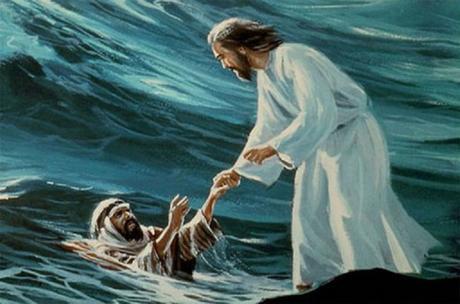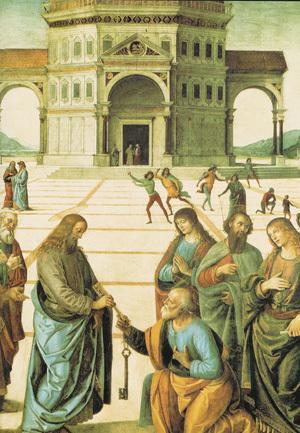
~Jesus saves Peter from drowning~
St. Peter, Prince of the Apostles
Everything that I have learned about St. Peter, who was previously known as Simon, reveals a very genuine and passionate individual — rough, blunt and outspoken, energetic and full of enthusiasm. More importantly, Peter was flawed and weak, just as you and I are flawed and weak. But Peter’s saving grace is that, despite all his very human flaws, he loved Our Lord, Jesus, with his whole being.
Born Simon, St. Peter was born in Bethsaida. He was married and lived in Capernaum with his mother-in-law in his home (Matthew 8:14; Luke 4:38). He was a fisherman in Lake Genesareth with his brother, Andrew (the first Apostle), and owned a boat.
One day, Andrew told Simon that they had found the Messiah and brought him to meet Jesus. Simon remained with Jesus for some time, accompanying Him to Galilee, Judaea and Jerusalem, and through Samaria back to Galilee (John 2-4). In Galilee, Simon and Andrew resumed their occupation as fishermen, until Jesus formally called the two brothers, as well as the sons of Zebedee, James and John, to be “fishers of men.” (Matthew 4:18-22; Mark 1:16-20; Luke 5:1-11). Thereafter, Simon remained with Jesus and heard the Sermon on the Mount and was present (the legal term is “percepient witness“!) during miracles that Jesus performed.
As we discussed in another post, “Do This In Remembrance of Me,” after Jesus spoke of the mystery of receiving His Body and Blood (John 6), many of Jesus’ disciples left Him, and so, Jesus asked his Apostles if they too were going to leave Him and Simon said straight away, “Lord, to whom shall we go? You have the words of eternal life. And we have believed and have known that you are the Holy One of God.”
Jesus gave a special place to Simon among the Apostles. Along with James and John, Simon was with Jesus during certain important events — the raising of Jairus’ daughter from the dead (Mark 5:37; Luke 8:51), the Transfiguration of Jesus (Matthew 17:1; Mark 9:1; Luke 9:28) and the Agony of Jesus in the Garden of Gethsemane (Matthew 26:37; Mark 14:33). Jesus entered Simon’s boat on Lake Genesareth to preach to the multitude on the shore (Luke 5:3), and when Jesus was miraculously walking upon the waters, Jesus called Simon to come to Him across the waters (Matthew 14:28).
While Jesus was journeying with his apostles, Jesus asked his apostles, “Whom do men say that the Son of man is?”
The apostles answered, “Some John the Baptist, and others Elias, and others Jeremiah or one of the prophets.”
Jesus then made his question specific for His apostles, “But whom do you say that I am?”
Simon answered, “Thou art Christ, the Son of the living God.”
 And Jesus said to him, “Blessed are thou, Simon Barjona, because flesh and blood hath not revealed it to thee, but my Father who is in heaven. And I say to thee: That thou art Peter (Kipha, a rock), and upon this rock I will build my Church, and the gates of hell shall not prevail against it. And I will give to thee the keys of the kingdom of heaven. And whatsoever thou shalt bind upon earth, it shall be bound in heaven; and whatsoever thou shalt loose on earth, it shall be loosed also in heaven.”
And Jesus said to him, “Blessed are thou, Simon Barjona, because flesh and blood hath not revealed it to thee, but my Father who is in heaven. And I say to thee: That thou art Peter (Kipha, a rock), and upon this rock I will build my Church, and the gates of hell shall not prevail against it. And I will give to thee the keys of the kingdom of heaven. And whatsoever thou shalt bind upon earth, it shall be bound in heaven; and whatsoever thou shalt loose on earth, it shall be loosed also in heaven.”
Then Jesus commanded his apostles that they should not tell anyone that he was Jesus the Christ (Matthew 16:13-20; Mark 8:27-30; Luke 9:18-21).
Jesus made Peter the head of the community of believers, and that through this foundation of Peter, the Kingdom of Christ could not be conquered, that the spiritual guidance of the faithful was placed in the hands of Peter as the special representative of Jesus Christ. The words, “bind and loose” are not metaphors, but Jewish juridical terms. The position of Peter among the other Apostles and in the Christian community was the basis for the Church of Christ. Therefore, Jesus personally installed Peter as Head of the Apostles and of His Church. The language that is used by Jesus clearly communicates that this foundation created for the Church by Jesus could not disappear with the person of Peter, but was intended to continue and did continue, as history shows, in the primacy of the Roman Catholic Church and its bishops, apostolic succession.
During the Last Supper, Jesus washed the feet of his apostles but Peter did not want Our Lord to do so as he opined it would be beneath Jesus. But Jesus said that if He did not wash his feet, he would have no part with Him when Peter said, “Lord, not only my feet, but also my hands and my head.” (John 13:1-10).
At the same time, however, Peter was not clear about the mission and work of Jesus our Savior, especially His Passion and suffering, as he opined that this could not be happening to the Messiah. So Jesus rebuked him, telling Peter that Satan had desired him that he might sift him as wheat. But Jesus prayed for him that his faith would not fail (Luke 22:31-32). Peter very enthusiastically said that he was ready to accompany his Master to prison and to death, only to be told he would deny Jesus three times: “’Amen, I say to you, this very night before the cock crows, you will deny me three times.’ Peter said to him, ‘Even though I should have to die with you, I will not deny you.’ And all the disciples spoke likewise.” (Matthew 26:30-35; Mark 14-26-32; Luke 22:31-34; John 13:33-38).
After the agony in the garden, Jesus’ Passion began. He was taken by the Roman soldiers. Frightened by what was happening, the apostles fled, except Peter who stealthily followed his Master to the courtyard of the High Priest. There, overcome by fear and weakness, Peter indeed denied Jesus three times, swearing that he did not know Him (Matthew 26:58-75; Mark 14:54-72; Luke 22:54-62; John 18:15-27). At the sound of the cock crowing a third time, Peter realized what he had done remembering Jesus’ prediction, and was distraught with sorrow and remorse for his actions.
How hurtful Peter’s denial must have been for our Lord! — to have a friend and follower deny that he knew Him. Peter’s denial perhaps was even more hurtful than Judas Iscariot’s betrayal….
But, unlike Judas who also belatedly realized the magnitude of his deed, Peter was remorseful and sought forgiveness. And so though Peter’s “sins be like scarlet, they may become white as snow….” (Isaiah 1:18)
How absolutely incredible and indescribable it must have been when the Resurrected Jesus appeared to Peter (Luke 24:34; 1 Corinthians 15:5). The time that the transfigured Christ spent with Peter and the remaining ten apostles must have been wonderful beyond all imagination and expectation!
Most importantly is when the Resurrected Christ appeared at the the Sea of Tiberias and asked Peter three times if he loved Him. Peter becoming frustrated with this question told Jesus each time that He knew that he loved Him. Jesus then instructed Peter to feed and defend His flock as he said to Peter, “Feed my sheep” (John 21:15-17).
And then, Jesus prophetically tells Peter how the apostle would die for Him:
“Amen, amen, I say to thee, when thou wast younger thou didst gird thyself and didst walk where thou wouldst. But when thou shalt be old, thou shalt stretch forth thy hands, and another shall gird thee and lead thee whither thou wouldst not. And this, He said signifying by what death Peter should glorify God” (John 21:20-23).
After Jesus ascended into heaven from Mount Olivet, Peter and the apostles returned to Jerusalem to await the receipt of the Holy Spirit whom Jesus had promised. Peter, as Christ’s designated leader, appointed Matthias to replace the fallen Judas. (Acts 1:15-26) This was the first appointment to the Apostolic College. And, after the descent of the Holy Spirit upon Mary and the Apostles, Peter delivered the first public sermon, proclaiming the life, death, resurrection and teachings of Our Lord, and won large numbers of converts to the early Church (Acts 2:14-41).
Peter continued to lead the Apostles and the Church, preached the Gospel, performed miracles by the power he had received from God, communicated with the far-flung early Church communities, worked with St. Paul who recognized Peter as the authorized head of the nascent Christian Church. We learn about Peter in the New Testament‘s Acts of the Apostles, the Epistles of St. Paul, and in the first and second Letters of Peter. The First Council of Jerusalem set forth a definitive decision concerning the obligations of converted pagans, and between Peter and Paul there was no dogmatic difference in their conception of salvation for both Jewish and Gentile Christians, that these converts were Christian brothers and sisters on an equal footing, that Jewish and Gentile Christians formed a single Kingdom of Christ.
Peter worked and labored in Rome during the last part of his life. He was martyred in Rome during the reign of Nero (A.D. 54-68). Tertullian said Peter was crucified. Eusebius the historian cited the authority of Origen that Peter was crucified upside down.
Peter had requested it, as he thought himself not worthy to be crucified in the same manner as his beloved Jesus the Christ.
And so, we end this with a prayer:
O God, who hast given unto Thy blessed Apostle Peter the keys to the kingdom of heaven, and the power to bind and loose; grant that we may be delivered, through the help of this intercession, from the slavery of our sins. Amen.
Sources:
- The New American Bible-New Testament
- Catholic Encyclopedia
- One Hundred Saints, Bulfinch Press
- Homily of His Holiness Benedict XVI, St. Peter’s Basilica, June 29, 2005
To my husband whose patron saint is St. Peter: “Happy Feast Day!”
~Joan
In 1968, Pope Paul VI made an announcement that the bones of St. Peter had been discovered below the Vatican, something that had already been known to a few for over two decades. Read the fascinating account of the discovery in The Bones of St. Peter: The First Full Account of the Discovery of the Apostle’s Tomb, by John Evangelist Walsh.
~Eowyn

